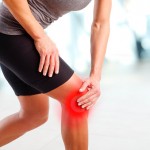

 Bursitis is a common cause of painful hips, knees, and elbows, but it can be managed with nonsurgical treatments. Bursitis occurs when the bursa – a small, fluid-filled sac that acts as a cushion and lubricator for our bones, muscles, and tends around our joints – becomes irritated or infected, causing pain through movement. If bursitis is caused by an infection, then medical treatment is required to combat it. But if no infection is found, then medical attention can help prevent the condition from worsening.
Bursitis is a common cause of painful hips, knees, and elbows, but it can be managed with nonsurgical treatments. Bursitis occurs when the bursa – a small, fluid-filled sac that acts as a cushion and lubricator for our bones, muscles, and tends around our joints – becomes irritated or infected, causing pain through movement. If bursitis is caused by an infection, then medical treatment is required to combat it. But if no infection is found, then medical attention can help prevent the condition from worsening.
Study author Daniel Aaron said, “Bursitis is a common cause of musculoskeletal pain and often prompts orthopedic consultation. One of the challenges facing clinicians is to differentiate bursitis from conditions with similar symptoms, including arthritis, tendinitis, fracture, tendon or ligament injury, and tumor. Additionally, bursitis arises from infectious and noninfectious causes, and distinguishing between the two can be challenging.”
“A thorough history and physical examination is required for accurate diagnosis, and in some cases, medical tests also may be used to help the clinician identify bursitis and determine whether or not infection is involved,” added Aaron.
Aaron explained, “Hip and heel bursitis usually result from ‘overuse’ syndromes involving underlying structures related to the tendons,” he noted. “Elbow and knee bursitis can be traumatic, due to either chronic low-level trauma or acute trauma, or infectious. Other inflammatory conditions can lead to bursitis as well.”
Aaron explained that many types of bursitis can be treated with nonsurgical procedures, like using ice packs or compressive dressings, modifying activities to reduce stress, taking antibiotics or anti-inflammatory medications, making corticosteroid injections, doing stretching exercises, and changing footwear if bursitis is in the heel.
If nonsurgical methods are unsuccessful, that is when surgical intervention may be required.
Aaron concluded, “By recognizing the presence of bursitis and determining whether or not infection is involved, clinicians can identify the best mode of treatment which will resolve symptoms and help the patient regain mobility.”
A person has bursitis when inflammation of the bursa occurs, causing pain when moving.
Bursitis can affect any joint, including the hip, knees, shoulder, elbow, buttocks, and thigh.
The common causes of bursitis are injury, infection, or a preexisting condition in which crystals form in the bursa.
 Typical symptoms of bursitis include pain, tenderness even without motion, swelling, and loss of movement. If bursitis is caused by an infection, additional symptoms may be seen such as fever, redness of the area, and the affected area feeling hot to touch. It’s important to note that symptoms also depend on the location of bursitis. Here are some additional symptoms experienced in specific locations in the body.
Typical symptoms of bursitis include pain, tenderness even without motion, swelling, and loss of movement. If bursitis is caused by an infection, additional symptoms may be seen such as fever, redness of the area, and the affected area feeling hot to touch. It’s important to note that symptoms also depend on the location of bursitis. Here are some additional symptoms experienced in specific locations in the body.
Hip: Pain may occur at the side of the hip and radiate to the thigh. The hip may be painful to touch. Walking, climbing stairs, and lying on your side becomes difficult.
Knee: Pain with movement is rare, unless the joint is significantly flexed.
Elbow: Swelling. Tenderness may occur if infection is present.
Heel: this type of bursitis is often associated with runners and is caused by overuse.
Unless an infection is present, bursitis can be well managed through self-care. It’s important to remember the acronym PRICEM when treating bursitis at home.
Protection – Protect the area from future injuries by wearing padding.
Rest – Limit the use of the joint and let it rest.
Ice – Apply ice packs a few times a day, but not directly onto your skin.
Compression – Wear compression bandaging to limit blood flow to the area as it contributes to swelling.
Elevation – Keep the joint elevated if possible to prevent blood from pooling in the area.
Medication – Take anti-inflammatory medication or antibiotics as instructed by your doctor.
In the rare instance, surgery may be recommended to drain the bursa in order to alleviate the inflammation.
Other treatment options include physical therapy, corticosteroid injections, and using assistive devices like a cane.
Some preventative means for bursitis include protecting the joints from injury, either through protective clothing, or by modifying or avoiding certain activities. Take a moment to rest if you are performing repetitive tasks, always warm up prior to exercise, and build strong muscles to protect your joints.
Other preventative methods include maintaining a healthy weight, using kneeling pads, lifting objects correctly, wheeling heavy loads, avoiding sitting for long periods of time, and exercising regularly.
Related Reading:
Walking barefoot indoors prevents plantar fasciitis, shin splints, bursitis, and tendinitis
For years people have been singing the virtues of good foot support, such as stress relief on your feet and shock absorption. However, a U.S. foot expert, who spent years studying the human foot core, tells us that going barefoot can improve balance and posture, as well as common injuries. Continue reading…
Achilles heel pain from Achilles tendinitis and bursitis, treatment and prevention
Achilles tendinitis and Achilles bursitis are two types of heel pain that result from inflammation in the Achilles tendon. The Achilles tendon is a band of tissue that connects the calf muscles at the back of the lower heel to the heel bone. Continue reading…
Copyright © www.orthopaedics.win Bone Health All Rights Reserved